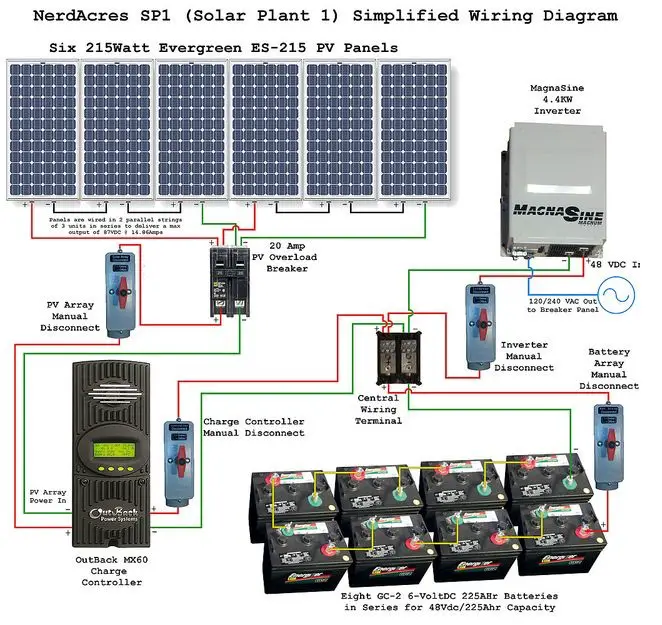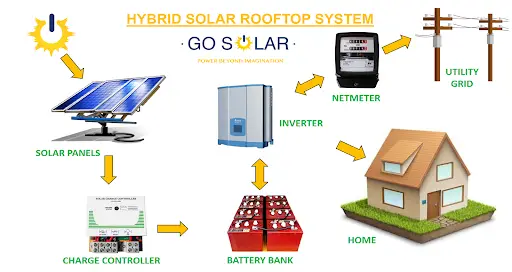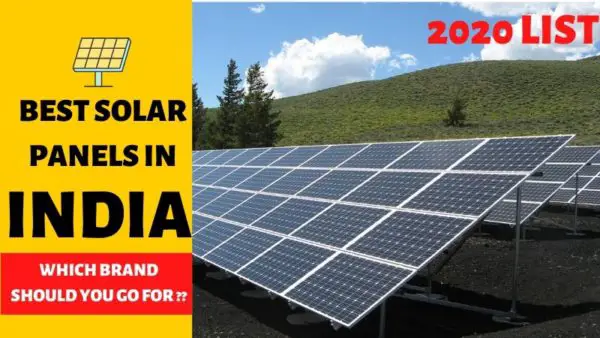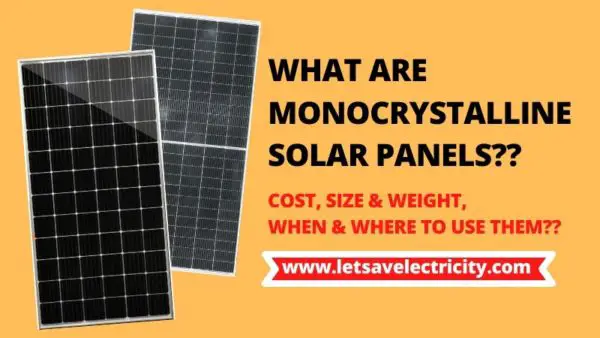Planning to install a solar system for your house and wondering what is hybrid solar system and whether you should install hybrid solar system.
In this article we will see what is hybrid solar system, how are they different from on grid solar system, when should you use hybrid solar system and all other things related to it.
What is Hybrid Solar System?
Hybrid solar system is a crossover between on grid and off grid solar system. It gives the benefits of being connected to the utility grid at the same time giving enough backup to power your house critical load in situation of a blackout.
The basic idea behind hybrid solar is that you generate power through your solar panels when sun is shining and store this power in the battery. Once your battery gets completely charged you will use the surplus power from solar to run your house appliances and if any more power is left then it will be exported to the utility grid.
The power stored in your battery will be used when your utility grid is down as a source of power backup. A hybrid solar system gives you all the benefits of a grid tied system while giving power backup in situation of power outage (on grid solar system shuts down when there is power outage).
Solar panels and battery alone doesn’t help to generate power you need other components too that will help to generate power.
A hybrid solar system consist of following components:
- Solar Panels: Solar panels are mounted on your roof or on any open space in your house which receives direct sunlight. Solar panels generate DC electricity.
- DCDB: DCDB (Direct Current Distribution box) is a combiner box with fuse, MCB & SPD device for protection. Main purpose of DCDB is to combine multiple strings of solar panels to one string which has two output, one positive and one negative.
- Charge Controller: As the name suggest a charge controller controls the amount charge going to your battery. It prevents overcharging of battery by regulating the amount of current going to the battery thereby increasing battery life.
- Hybrid Inverter: A hybrid inverter converts DC electricity from the battery to AC electricity that can be used to power household appliances.
- ACDB: ACDB (Alternating Current Distribution box) is a safety device with fuse, MCB & SPD device for protection. Main purpose of ACDB is to safeguard your appliances from any malfunction in the hybrid inverter.
- Batteries: Batteries be it Li Po (Lithium polymer), lithium ion or lead acid are used to store the DC electricity generated by your solar panels.
Now that you know the list of components required to run a solar hybrid system, let’s look how they are connected to generate and transmit power where it is needed.
Hybrid Solar System Connection:

- Solar panels on your rooftop are connected to each other in series and parallel arrangement and their output is fed into a charge controller.
- Other end of the charge controller is connected to the battery to prevent overcharging of battery.
- Batteries are connected to the hybrid solar inverter.
- Output of the hybrid solar inverter is fed to the net meter and then to your house distribution panel, from there power goes to your house to power your appliances.
Hybrid Solar System Working:

- Solar panels generate DC electricity, this DC electricity is fed to the charge controller.
- The charge controller regulates the charge and sends power to the battery to charge them.
- Whenever there is power requirement the hybrid inverter pulls power from the batteries and converts the DC electricity into AC electricity.
- From hybrid Inverter this AC power is send to the net meter which is connected to your house and utility grid.
Hybrid solar system working in different scenario:
What will happen when grid is down in the morning or at night, what will happen if your solar is producing less than what you need and what will happen if your solar is producing more than what your solar needs. Let’s look into these scenario one by one.
Hybrid solar system working when there is power outage:
If there is power outage during morning or afternoon when sun is shining and your solar is generating electricity, your solar system won’t shut down as it does in an on grid solar system, but it will isolate itself from the grid and keep on running.
Whatever electricity your house needs during power outage will be pulled from the battery. Let me tell you one thing, if your solar system is of 3 kW and at a time if you are running more than 3 kW of appliance on it when the grid is down then your inverter will shutdown.
Whenever there is power outage, at all times the cumulative wattage of all your house appliances which are running at the same time should be less than your inverter wattage.
What happens when solar produces less than what is needed:
Let’s say it’s rainy outside and your hybrid solar system only produced 10 kWh of electricity in the entire day but you need 15 kWh to power your house appliances, then in that case you will pull the remaining 5 kWh from the utility grid.
What happens when solar produces more than what is needed:
Let’s say your hybrid solar system produced 15 kWh in the entire day, out of which you only used 5 kWh as your live consumption (when the sun was shining) then the rest of the rest the 10 kWh, will be given to the battery until battery is fully charged and then the remaining units is exported to the utility grid.
Don’t worry at all times you will be able to power your house appliances if your grid is up and running (no power cut).
Watch this 5 minute video on setup and working of 3 kW Hybrid Solar System.
If hybrid solar system is that good then why should I install a grid tied system anyways it stops working during power failure. Before you get this thought let me tell you one thing every system is designed for a specific requirement and conditions and should be used in those conditions only to maximize the results.
When to Go For Hybrid Solar System:
1. When feed in tariff is low: At some places, conventional on grid solar system does not give maximum savings as there are feed in tariff in place which changes with time.
During day when your solar is generating power, your house electricity consumption is very less (as most people are out of the house) and if you have installed a grid tied solar system then majority of the electricity will be exported to the grid.
If your area has feed in tariff in place then, during afternoon when you export power you will get less cost per unit of electricity whereas during night when you import the same power you have to pay more for per unit of electricity.
However if you install a hybrid solar system then instead of exporting the surplus power generated in the afternoon to the utility grid you will store it in your battery and use it at night when the tariff rates are high. Hence more electricity bill savings.
2. Frequent power outage: If you area has frequent power outage and you want to install a solar system to reduce your dependency on the utility grid and have adequate backup power to run your critical load then go for solar hybrid system.
If you live in a city where there are no power outages and the solar net metering policy is good then install a grid tied solar system, it will be cheaper for you and there will be less maintenance.
Advantages of Hybrid Solar System:
- Allows you to store excess solar or low cost (off-peak) electricity.
- Allows use of stored solar energy during peak evening times when tariff’s are high. Hence more savings in electricity bill.
- Hybrid system gives you power backup for emergency situations.
- Reduces your power consumption and dependence from the utility grid.
- Helps to reduce your carbon footprint.
Disadvantages of Hybrid Solar System:
- Hybrid solar system has higher upfront cost, mainly due to the high cost of batteries.
- Longer payback time – Higher return on investment
- More complex installation requires more room and higher install cost.
- Maintenance cost of hybrid system is high as you have to change battery after 4 – 6 years.
- Backup power may limit how many appliances you can run at the same time (depending on the type of hybrid inverter and its capability). However the idea of backup power is to only run critical loads.
Few things to consider while going for hybrid solar system:
If you need a hybrid solar system for your house then you should consider the following things before installing one.
- Get Enough Power Backup: If you are installing hybrid system then chances are there are frequent power outage in your area and you need power backup. In that case make sure you get enough batteries to run your critical load for at least 1-2 days, because if there is power outage and your battery fizzes out in an hour then your hybrid solar is not worth the investment.
- Go With Reputed Brands: Hybrid solar system are expensive and I think it a long term investment hence you should not compromise on the quality of products you use. Here is a list of best solar panels manufacturer.
- Maintenance is Must: Always keep your solar panels clean and make sure there is no shadow on it. If you can’t do the cleaning & maintenance yourself then hire a cleaning contractor because how well you maintain your solar system will govern how well the system performs and how long the system performs.
Conclusion on Hybrid solar system:
I would like to highlight a point that hybrid solar system is not for everyone. If your area has a good solar net metering policy and there are no frequent power outages then always go for a solar on grid system.
Solar on grid system will cost you less and there is very less maintenance cost.
However if your locality gets daily load shedding for an hour or so, or there are frequent power outage then you should opt for a hybrid solar system.
If you liked this article then feel free to share it on WhatsApp, Facebook, Reddit.
Leave your valuable feedback in the comments section.
Thank You 🙂
References:





